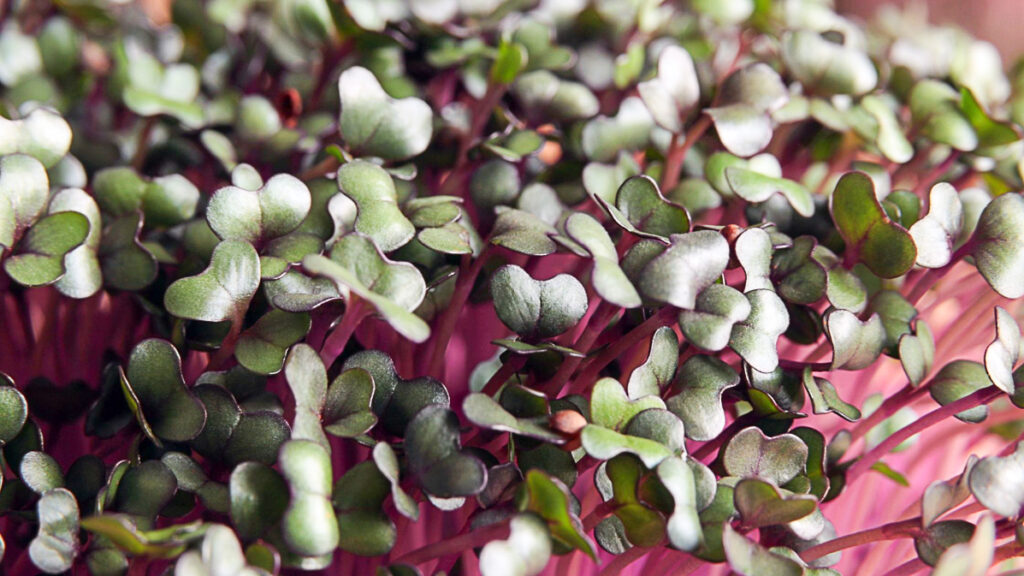Radish microgreens are delicious and popular among microgreen growers. Fortunately, radish is super easy to grow. Let’s dive in and learn how to grow radish microgreens at home.
*This post contains compensated links. Find more info in my DISCLAIMER. As an Amazon Associate, I earn from qualifying purchases.
What Are Radish Microgreens?
Microgreens are young green vegetables that are between one and three inches tall. Microgreens have a rich nutrient content with an aromatic flavor. You harvest microgreens between the sprout and baby green stage.
Radish microgreens are baby plants of full-grown radish bulbs. The microgreens don’t taste like the leaves of a full-grown radish bulb but more like radish bulbs. Radish microgreens contain a high concentration of vitamins and minerals. Radish microgreens will give you 40 times more nutrients than fully grown radish. Some of the benefits of radish microgreens include:
- Radish microgreens contain folate and vitamin B6, which improve the cardiovascular system.
- Microgreens contain high glucosinolate, which helps prevent cancer.
- Radish microgreens are low in calories which help reduce weight. High levels of Vitamin C in green radish help burn body fat.
- Radish microgreens are rich in Vitamin C, which helps destroy dangerous molecules that we expose our skin to.
- The antioxidants in radish microgreens assist in the management of diabetes and Alzheimer’s disease.

Growing Radish Microgreens At Home
If you want to begin growing microgreens, then radish microgreens are the perfect place to start. Growing radish microgreens is easy and fast. This type of microgreens needs little preparation and care. You will harvest in only a few days.
One of the benefits of radish microgreen is their seeds will germinate quickly and are easy to handle. Radish sprouts grow like weeds and are easy to harvest.
There are different varieties of radish microgreens. It is wise to decide which variety you want to grow. Radish varies in color, size, and shape. Radish microgreen varieties differ in their growth habits.
Common Radish Varieties
Daikon radish: The most common radish with large, carrot-shaped, and juicy white flesh. Daikon radish is hotter than red radish and milder than black radish. This radish variety has a soft flavor and is crispy.
Spanish radish: Also known as black radish, it has a snowy white flesh covered with a black exterior. This radish variety is like turnip, is sharp when raw, and drier than other radish varieties. Black radish is commonly grown commercially.
French breakfast radish: This variety is sharp with a delicate and sweet flavor. The radish bottom is white with a pink top and features an oblong shape.
Chinese radish: The radish with many names including daikon, white radish and Japanese radish. These are commonly plump and elongated, much like a carrot except white.
Round radish: One of the most common radishes, it can be red, white, purple, or pink. However, red is the most common. Round radish is often sold as Easter radish because it resembles dyed Easter eggs.
Horseradish: This variety has a highly complex flavor and charming sweetness. Ancient Greeks and Egyptians used horseradish for its medicinal value.
Watermelon radish: As the name indicates, this radish is large in size and has a mild flavor. The radish is white and covered with a layer of thin greenish skin. A red to pink interior resembles a watermelon hence the name watermelon radish.
The Best Radish Microgreen Systems For Growing At Home
Growing radish microgreens is pretty simple. However, purchasing a microgreen growing kit makes the task much easier, especially for beginners. Most growing kits will contain all you need for growing microgreens indoors. Let’s have a look at this radish microgreens kit.
Mini Microgreens Growing Kit

This growing kit has everything you need to grow radish microgreens in ten days. The kit will make growing radish fun and easy.
This kit includes the following:
- A growing container
- Pre-fertilized soil puck
- A humidity lid
- Organic seeds
- A mist sprayer
- Detailed instructions
The kit is suitable for growing microgreens indoors.
Check out some of our other at-home growing kits:
The 5 Best Hydroponics Starter Kits For Beginners
5 Tips For Growing Arugula Microgreens At Home
A Quick Guide To Growing Radish Microgreens At Home
Growing radish microgreens is exciting and easy once you know the basics of planting radish seeds. Here are some facts about growing radish microgreens.
- Radish microgreens germinate in one to three days after planting radish seeds. Radish microgreen seeds need a moist condition. A temperature of between 65 and 85 degrees Fahrenheit is ideal.
- Growing radish microgreens need full sunlight. However, radish microgreen seeds need complete darkness to germinate. If you are growing microgreens indoors, it is best to place them near a window or provide artificial lighting.
- The best growing medium for radish microgreens should be light and fine-grained. Potting soil or mix is best, although other mediums such as coconut coir are also ideal.
- Ensure you cover your container after planting radish seeds. Leave the seeds in darkness for two to three days until they completely germinate.
- Radish microgreens need only a little fertilizer to grow. Nature your radish with low-nitrogen soil and a lot of organic materials mix. Most radish varieties will absorb their nutrients from an ordinary potting mix.
Our 5 Top Tips For Growing Radish Microgreens
Tip 1 Choose The Best Variety
There are different varieties of radish, which differ in their growth habits. It is, therefore, essential to choose a variety that will work for you. It is helpful to know the common types available and their growing requirements. Ensure that the variety you choose fits well with the season you want for growing radish.
Tip 2 Proper Lighting
Radish microgreens thrive well in full sunlight. However, radish microgreen seeds need darkness to germinate. Ensure that your cover your grow tray for up to three days to allow all the seeds to germinate.
After the seeds germinate, uncover the tray for adequate sunlight. If you are growing microgreens indoors, then LED grow lights are a good option for providing enough light.
Tip 3 Proper Spacing
Ensure you have the recommended depth for planting radish seeds. Small radish needs a depth of one centimeter, while large radish may need up to four centimeters.
Radish microgreen seeds are tiny. Ensure that you level the potting mix properly before sowing the seeds. Scatter the seeds on the soil as even as possible to maximize the space. Use a shaker bottle to spread the seeds evenly.
Tip 4 Proper Watering
Ensure that the soil is moist and not soaked. Use a mist sprayer to evenly and adequately water the soil. Once radish sprouts appear, start watering them from the bottom. It would be best if you memorized the weight of your growing tray. The weight will let you know when to water again.
Add a quarter-inch of water into a watering tray and dip it in the growing tray. Let the potting soil absorb water from the bottom. Watering radish microgreens from below keeps the stems and leaves dry. Dry radish sprouts reduce the possibility of damping-off disease and prevent soil from splashing onto the plants.
Tip 5 Use A Microgreen Growing Kit
Microgreen growing kits come with everything you need to grow radish Microgreens. The kit will have instructions that will make it easy and fun to grow radish microgreens.
If you want to start growing microgreens, radish microgreens are the way to go. Growing radish at home is fun and easy. They do not need a lot of care, making them the best for a beginner. You can also opt to use a kit and grow radish indoors.
FAQs – Growing Radish Microgreens
From start to finish, you can grow radish microgreens in as little as 10 days. They are easily some of the fastest and easiest microgreens to grow at home.
Unfortunately, like most microgreens, radish microgreens don’t re-grow after they’ve been cut. Knowing it’s only takes over a week for them to grow, this shouldn’t be a concern.
